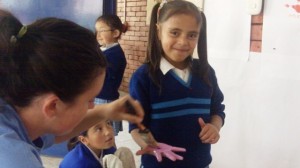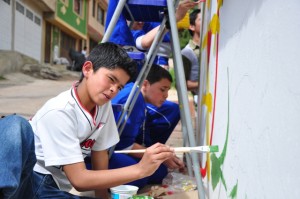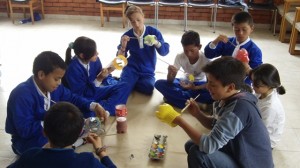 Four students used a $10,000 Davis Foundation “Projects for Peace” grant this summer to spend five weeks in Bogotá, Colombia, and run a youth program for 80 school children ages 5 to 16. They worked with Fundación Ayuda por Colombia (FAC), a nonprofit organization that operates an afterschool program for these children during the school year.
Four students used a $10,000 Davis Foundation “Projects for Peace” grant this summer to spend five weeks in Bogotá, Colombia, and run a youth program for 80 school children ages 5 to 16. They worked with Fundación Ayuda por Colombia (FAC), a nonprofit organization that operates an afterschool program for these children during the school year.
Civil engineering majors Lindsey Getches ’11 (Wakefield, R.I.) and Bryan Hendrickson ’10 and engineering studies majors Martín Melendro ’11 (Bogota, Colombia) and Ben Swartout ’11 (Upton, Mass.) constructed the creative learning program. Denise Galarza Sepúlveda, assistant professor of foreign languages and literatures and chair of the Latin American and Caribbean Studies program, was the group’s adviser. She and Julia Goldberg, associate dean of the College, and Nancy Ball, director of sponsored programs, guided the students through the grant application process.
 The group will discuss its Bogotá Summer Cooperative Education program at a brown bag lunch noon Tuesday, Nov. 9, in Hugel Science Center room 100. There also will be a silent auction noon Saturday, Nov. 13, at Café Terra, a sustainable coffee shop in Easton. Proceeds will benefit FAC.
The group will discuss its Bogotá Summer Cooperative Education program at a brown bag lunch noon Tuesday, Nov. 9, in Hugel Science Center room 100. There also will be a silent auction noon Saturday, Nov. 13, at Café Terra, a sustainable coffee shop in Easton. Proceeds will benefit FAC.
A civil engineering major, Hendrickson was fascinated by the differences in buildings and transportation systems between Bogotá and U.S. cities. But it was art that left the most powerful impression. The Lafayette group helped the children design a mural for the FAC building, coming up with three concepts and allowing them to decide which to use.
“We included all the children in the process, encouraged critical thinking, and provoked meaningful discussion about the reasons behind their choices,” he says. “Having the children come outside the building where they spent most of their day and make a work of art just blew me away. I could tell that providing them the opportunity to be involved in changing their physical space brought an excitement to their lives that will not be forgotten.”
 The project began as a simple cardboard representation of a tree, the roots representing the concepts of respect, community, creativity, and fun. When the children had group discussions, only the person holding the small, yellow “ball of peace” was allowed to speak. To solidify the root concepts into a trunk, fun learning games like hot lava and Simon says and sports like soccer and basketball helped the children build tolerance and respect. Colegio San Carlos, a local high school, provided access to safe outdoor areas for play.
The project began as a simple cardboard representation of a tree, the roots representing the concepts of respect, community, creativity, and fun. When the children had group discussions, only the person holding the small, yellow “ball of peace” was allowed to speak. To solidify the root concepts into a trunk, fun learning games like hot lava and Simon says and sports like soccer and basketball helped the children build tolerance and respect. Colegio San Carlos, a local high school, provided access to safe outdoor areas for play.
Finally, the tree’s flowers represented all the people needed to build a successful summer program. The children combined fun artwork with learning about sustainability by using recycled egg cartons to hold paint and crafting flowers from plastic bottles to add to the cardboard tree. They also used plastic bottles as pots for bean plants the children took home as souvenirs.
To celebrate their last day at FAC, the group presented a cake that read “Thanks for Sharing” and a real tree to preserve the metaphor of their summer program. Hendrickson hopes to return to Bogotá to visit the finished mural, which was completed after he left the country.
Art is central to Hendrickson’s life. He is spearheading a grassroots entrepreneurial eco-arts movement in Trenton, N.J., called Trenton Atelier, a collaboration of artists interested in cultivating a community engaged in experiential learning and dedicated to the environment. The group focuses on creating artwork and functional objects from recycled materials.
The concepts of Trenton Atelier are very similar to those Hendrickson helped teach the Colombian children, an experience he describes as “humbling.”
“As we summited Monserrate, the tallest point overlooking Bogotá, peering above almost nine million people, I could see everything,” he recalls. “Miles and miles of tiny blinking lights strung like an endless Christmas tree, cars and buses moving along the thousands of roads; it was breathtaking. The magnitude of humanity before me – to think that cities like this are where the majority of the world lives – was so powerful.”


